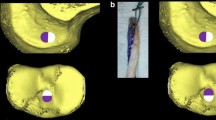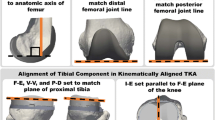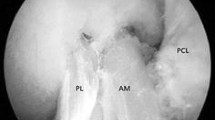Abstract
Introduction
Surgical reconstruction of the posterior cruciate ligament (PCL) is recommended in acute injuries that result in severe tibial subluxation and instability. The surgical outcome level may be affected by the tibial fixation site. In response to a 110-N posterior tibial load, kinematics and in situ forces of anatomical soft-tissue graft fixation in single-bundle PCL reconstruction using an interference screw fixation are significantly closer to those in the intact knee than with extracortical fixation with two staples.
Materials and methods
Using a robotic/universal force moment sensor (UFS) testing system, we examined joint kinematics and in situ forces of porcine knees following single-bundle PCL reconstruction fixed at two different tibial fixation sites: anatomical interference screw and extracortical fixation.
Results
The site of the tibial graft fixation had significant effect on the resulting posterior displacement and in situ forces of the graft. Both PCL reconstruction techniques reduced the posterior tibial translation significantly. Proximal fixation techniques provided significantly less posterior tibial translation than extracortical fixation. Single-bundle PCL reconstruction with an interference screw showed higher in situ forces of the graft than the extracortical fixation.
Conclusions
The kinematics and in situ forces of a single-bundle PCL reconstruction using an interference screw fixation technique are superior to the primary stability of an extracortical fixation with staples.




Similar content being viewed by others
References
Allen CR, Kaplan LD, Fluhme DJ, Harner CD (2002) Posterior cruciate ligament injuries. Curr Opin Rheumatol 14:142–149
Barrett GR, Savoi FH (1991) Operative management of acute PCL injuries with associated pathology: long term results. Orthopedics 14:687–692
Becker R, Schroeder M, Roepke M, Starke C, Nebelung W (1999) Structural properties of sutures used in achoring multistranded hamstrings in anterior cruciate ligament reconstruction: a biomechanical study. Arthroscopy 15:297–300
Boyton MD, Tietjens BR (1982) Long term follow up of the untreated isolated posterior cruciate ligament deficient knee. Am J Sports Med 24:306–310
Brand J, Weiler A, Caborn DN, Brown CH, Johnson D (2000) Graft fixation in cruciate ligament reconstruction. Am J Sports Med 28:761–773
Burkart A, Debski RE, McMahon PJ, Rudy T, Fu FH, Musahl V, van Scyoc A, Woo SL (2001) Precision of PCL tunnel placement using traditional and robotic techniques. Comput Aided Surg 6:270–278
Carlin GJ, Livesay GA, Harner CD, Ishibashi Y, Kim HS, Woo SL (1996) In-situ forces in the human posterior cruciate ligament in response to posterior tibial loading. Ann Biomed Eng 24:193–197
Clancy WG, Sutherland TB (1994) Combined posterior cruciate ligament injuries. Clin Sports Med 13:629–647
Clancy WG, Shelbourne KD, Zoellner GB, Keene JS, Reider B, Rosenberg TD (1983) Treatment of knee joint instability secondary to rupture of the posterior cruciate ligament. Report of a new procedure. J Bone Joint Surg Am 65:310–322
Dandy DJ Pusey RJ (1982) The long tem results of unrepaired tears of the posterior cruciate ligament. J Bone Joint Surg Br 64: 92–94
Fanelli GC, Edson CJ (1995) Posterior cruciate ligament injuries in trauma patients. II. Arthroscopy 11:526–529
Fanelli GC, Giannotti BF, Edson CJ (1994) The posterior cruciate ligament arthroscopic evaluation and treatment (current concepts review) Arthroscopy 10:526–529
Fleming RE, Blatz DJ, McCarroll JR (1981) Posterior problems in the knee: posterior cruciate insufficiancy and posterolateral rotatory insufficiany. Am J Sports Med 9:107–113
Fujie H, Livesay GA, Fujita M, Woo S LY (1996) Forces and moments in six-DOF at the human knee joint: mathematical description for control. J Biomech 29:1577–1585
Fuss FK (1991) Anatomy and function of the cruciate ligaments of the domestic pig (Sus scrofa domestica): a comparison with human cruciates. J Anat 178:11–20
Galloway MT, Grood ES, Mehalik JN, Levy M, Saddler SC, Noyes FR (1996) Posterior cruciate reconstruction. An in vitro study of femoral and tibial graft placement. Am J Sports Med 24:43–445
Grood ES, Hefzy MS, Lindenfeld TN (1997) Factors affecting the most isometric femoral attacments. I. The posterior cruciate ligament. Am J Sports Med 17:187–207
Giffin JR, Haemmerle MJ, Vogrin TM, Harner CD (2002) Single- versus double-bundle PCL reconstruction: a biomechanical analysis. J Knee Surg 15:114–120
Harner CD, Hoeher J (1998) Evaluation and treatment of posterior cruciate ligament injuries. Am J Sports Med 26:471–482
Harner CD, Janaushek MA, Ma CB, Kanamori A, Vogrin TM, Woo SL (2000) The effect of knee flexion angle and application of an anterior tibial load at the time of graft fixation on the biomechanics of a posterior cruciate ligament-reconstructed knee. Am J Sports Med 28:460–465
Harner CD, Janaushek MA, Kanamori A, Yagi M, Vogrin TM, Woo SL (2000) Biomechanical analysis of a double-bundle posterior cruciate ligament reconstruction. Am J Sports Med 28:144–151
Harner CD, Vogrin TM, Hoeher J, Ma CB, Woo SL (2000) Biomechanical analysis of a posterior cruciate ligament reconstruction. Deficiency of the posterolateral structures as a cause of graft failure. Am J Sports Med 28:32–39
Hoher J, Vogrin TM, Woo SL, Carlin GJ, Aroen A, Harner CD (1999) In situ forces in the human posterior cruciate ligament in response to muscle loads: a cadaveric study. J Orthop Res 17:763–768
Hoher J, Scheffler S, Withrow J, Livesay GC, Debski RE, Fu FH, Woo SL (2000) Mechanical behavior of two hamstring graft constructs for reconstruction of the anterior cruciate ligament. J Orthop Res 15:465–461
Hoher J, Scheffler S, Weiler A (2003) Graft choice and graft fixation in PCL reconstruction. Knee Surg Sports Traumatol Arthrosc 11:297–306
Insall JN, Hood RW (1982) Bone block transfer of the medial head of the gastrocnemius for posterior cruciate insufficiency. J Bone Joint Surg Am 64:691–699
Ishibashi Y, Rudy TW, Livesay GD, Debski RE, Fu FH, Woo S LY (1997) The effect of Anterior Cruciate Ligament graft fixation site at the tibia on knee stability: evaluation using a robotic testing system. Arthroscopy 13:177–182
Lambert KL (1983) Vascularized patellar tendon graft with rigid internal fixation for anterior cruciate ligament insufficiency. Clin Orthop 172:85–89
Lipscomb AB, Anderson AF, Norwig ED, Howis WD, Brown DL (1993) Isolated posterior cruciate ligament reconstruction. Long term results. A J Sports Med 21:490–496
Livesay GA, Rudy TW, Woo SL, Runco TJ, Sakane M, Li G, Fu FH (1997) Evaluation of the effect of joint constraints on the in situ force distribution in the anterior cruciate ligament. J Orthop Res 15:278–284
Margheritini F, Rihn J, Musahl V, Mariani PP, Harner C (2002) Posterior cruciate ligament injuries in the athlete: an anatomical, biomechanical and clinical review. Sports Med 32:393–408
Mariani PP, Adriani E, Santori N, Maresca G (1997) Arthroscopic posterior cruciate ligament reconstruction with bone-tendon-bone patella graft. Knee Surg Sports Traumatol Arthrosc 5:239–244
Mariani PP, Margheritini F, Camillieri G (2002) One stage arthroscopically assisted anterior and posterior cruciate ligament reconstruction. Arthroscopy 17:700–707
Mariani PP, Becker R, Rhin J, Margheritini F (2003) Surgical treatment of posterior cruciate ligament and posterolateral corner injuries. An anatomical, biomechanical and clinical review. Knee 10:311–324
Mejia EA, Noyes FR, Grood ES (2002) Posterior cruciate ligament femoral insertion site characteristics. Importance for reconstructive procedures. Am J Sports Med 30:643–651
Miller MD, Olszewski AD (1995) Posterior cruciate ligament injuires: new treatment options. Am J Knee Surg 8:145–154
Nagarkatti DG, McKeon BP, Donahue BS (2001) Mechanical evaluation of a soft tissue interference screw in free tendon anterior cruciate ligament graft fixation. Am J Sports Med 29:67–71
Noyes FR, Barber-Westin SD (1994) Surgical restoration to treat chronic deficiency of the posterolateral complex and cruciate ligaments of he knee joint. Am J Sports Med 24:415–426
Ogata K, McCathy JA (1992) Measurements of length and tension patterns during reconstruction of the posterior cruciate ligament. Am J Sports Med 20:351–355
Parolie JM, Bergfeld JA (1986) Long term results of non operative treatment of isolated posterior cruciate ligament injuries in the athlete. Am J Sports Med 20:35–38
Petersen W, Tillmann B (2000) Anatomie des hinteren Kreuzbandes. Arthroskopie 13:3–10
Race A, Amis AA (1994) The mechanical properties of the two bundles of the human posterior cruciate ligament. J Biomech 27:5–17
Race A, Amis AA (1998) PCL reconstruction. In vitro biomechanical comparison of “isometric versus single and double bundled ‘anatomic’ grafts. J Bone Joint Surg Br 80:173–79
Rudy TW, Livesay GA, Woo SL, Fu FH (1996) A combined robotic/universal force sensor approach to determine in situ forces of knee ligaments. J Biomech 29:1357–1360
Saddler SC Noyes FR, Grood ES et al (1996) Posterior cruciate ligament anatomy and length-tension behavior of PCL surface fibers. Am J Knee Surg 9:194–199
Staehlin AC, Sudkamp NP, Weiler A (2001) Anatomic double-bundle posterior cruciate ligament reconstruction using hamstring tendons. Arthroscopy 17:88–97
Tsuda E, Fukuda Y, Loh JC, Debski RE, Fu FH, Woo SL (2002) The effect of soft-tissue graft fixation in anterior cruciate ligament reconstruction on graft-tunnel motion under anterior tibial loading. Arthroscopy 18:960–967
Vogrin TM, Hoeher J, Aroen A, Woo SL, Harner CD (2000) Effects of sectioning the posterolateral structures on knee kinematics and in situ forces in the posterior cruciate ligament. Knee Surg Sports Traumatol Arthrosc 8:93–98
Woo SL, Debski RE, Wong EK, Yagi M, Tarinelli D (1999) Use of robotic technology for diathrodial joint research. J Sci Med Sport 2:283–297
Woo SL, Debski RE, Withrow JD, Janaushek MA (1999) Biomechanics of knee ligaments. Am J Sports Med 27:533–543
Acknowledgements
The authors thank the Deutschsprachige Arbeitsgemeinschaft für Arthroskopie (AGA) for funding of the robot. T.Z. is currently AGA Research Fellow at the Department of Orthopaedic Surgery, University of Pittsburgh. This fellowship is supported by Aircast. The authors thank Prof. Dr. Savio L.-Y. Woo since without his education and technical support an establishment of the robotic/UFS testing system would not have been possible. We also thank Mr. N. Settele from Kuka Robotics (Wolfsburg, Germany) for his technical advice. The UFS was provided by Amatech (Augsburg, Germany). We thank Prof. Schütt from the Department of Robotic Technology of the University Westkueste in Heide, Germany, for his technical support. The precise technical work of Mr. J. Studt and Mr. S. Zander is also deeply appreciated. The implants and instruments used in the present study were donated by Smith&Nephew (Hamburg, Germany). None of the authors received financial support of any commercial parties.
Author information
Authors and Affiliations
Corresponding author
Rights and permissions
About this article
Cite this article
Zantop, T., Lenschow, S., Lemburg, T. et al. Soft-tissue graft fixation in posterior cruciate ligament reconstruction: evaluation of the effect of tibial insertion site on joint kinematics and in situ forces using a robotic/UFS testing system. Arch Orthop Trauma Surg 124, 614–620 (2004). https://doi.org/10.1007/s00402-004-0741-y
Received:
Published:
Issue Date:
DOI: https://doi.org/10.1007/s00402-004-0741-y




